robots

De toujours tu seras l'antépénultième peril
Kévin Ardito (FR)
This sculptural and musical installation diffuses cover versions of Billy Joel’s song Honesty. It uses digital and robotic media to question our relationship with transparency and lies in an entertaining and mischievous way: skull-shaped robots singing a song about honesty. The recorded voices lend some warmth to the robotic coldness of the artwork by adding an organic element to the robots, blurring assessments of identity or the reasons for their presence. The background simulates an Aurora Borealis, which is reflected on the skulls and the surrounding environment.
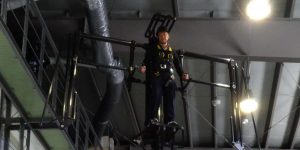
Big Robot Mk.2
Hiroo Iwata (JP)
This video installation shows the largest movable robot in the world. Large humanoid robots, such as Gundam or Macros, are popular in Japanese animation and Manga. What if robots of this kind appeared in the real world? The existence of real large-scale robots may inspire the audience to be courageous. Thus, it has potential as an art form. The Big Robot Project aims to develop the world’s largest rideable robot. The Big Robot Mk.2 is an extension of the *Big Robot Mk.1* which was exhibited at Ars Electronica 2016.
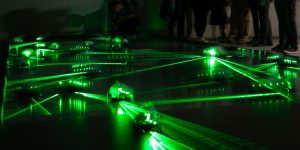
Lasermice
So Kanno (JP)
Lasermice is a swarm robotic installation with 60 small robots, inspired by the synchronous behavior of insects like fireflies. Robots create a visible network via laser light-photodetector communication and generate a rhythm that continuously changes and that’s made audible by a solenoid striking the floor. The combination of a visible network and an audible rhythm is spatially deployed.
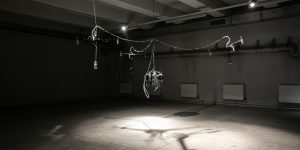
Poise→[d]
Dmitry Morozov / ::vtol:: (RU)
Poise→[d] is a hybrid installation that uses chemical and physical reactions to control its behavior and sound synthesis. The installation consists of the main control unit and three balancing robots. The main control unit has three core systems where the reactions occur, with everything analyzed by a computer algorithm using cameras.
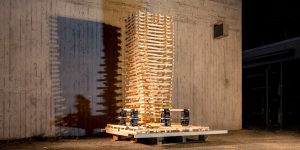
Distributed Robotic Assembly for Timber Structures
Samuel Leder (US), Ramon Weber (CH)
Dieses multidisziplinäre Forschungsprojekt beschäftigt sich mit autonomen maschinellen Kollektiven, die bauliche Strukturen erstellen.
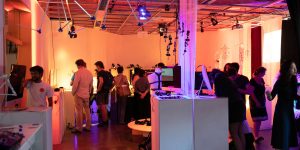
Content One Campus – Network Intelligence
Organized by Ministry of Culture, Sports and Tourism of the Republic of Korea (MCST) and Korea Creative Content Agency (KOCCA) (KR)
With its disruptive AI, robot, data, 3D, and VR technologies, the Fourth Industrial Revolution has triggered a fundamental change in the way we live, work and relate to one another. The speed and breadth of the economic, political, social, and cultural changes produced by technology are literally beyond our comprehension. It is time to think, act, and collaborate to bring about new methodologies for the coming age. What, then, will be the best strategic approach? What manners of collaboration are necessary? How can we educate our talented creators?
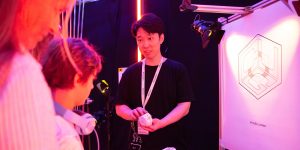
CuGo
Kongpyung Moon (SK), Peng Gao (CHN)
CuGo is a board game where humans interact with modular robots (H-RMR). As a platform for people and robots to collaborate, CuGo not only encourages players to observe and understand how the multi-axis RMR robots behave, but also how they might be utilized. CuGo also opens up questions about the role of humans within environments populated by autonomous agents.
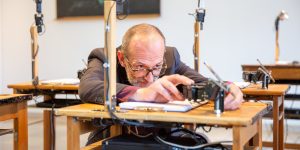
Human Study #4, La Classe
Patrick Tresset (FR)
Nine robots act as stylized pupils in the "classroom." They learn to pass the time and obey the teacher during the lesson represented in theatrical performance. Even after revolting, they get back in line to follow what is being taught. Childhood memories, Jacques Tati, Theodor W. Adorno and Michel Foucault influenced Patrick Tresset for this art installation.
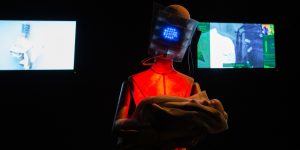
ROBOTIKA, The Nannybot
Joaquín Fargas (AR)
Robotika is a cyber nanny whose duty is to preserve the human race. Robotika challenges the limits of the human being concept. It is a robot vested with artificial intelligence that shall act as a “galactic ark,” looking for a suitable environment for human development.
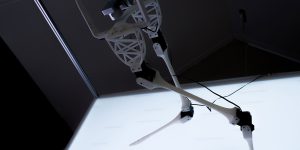
Aerial-Biped
Azumi Maekawa (JP), Shunji Yamanaka (JP)
Aerial-Biped is a prototype for exploring a new experience with a physical biped robot. In this work using a quadrotor, we aim to separate the body shape and motion design.


